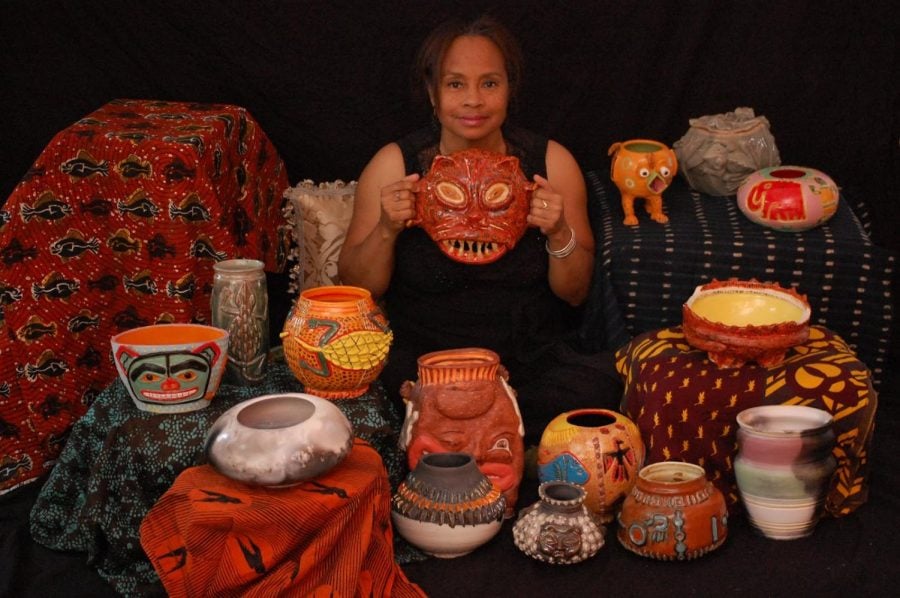Evanston potter Cherie Lockett crafts historically inspired ceramics
Photo courtesy of Cherie Lockett
Potter Cherie Lockett surrounded by her ceramic creations, which reflect Indigenous art throughout history. Lockett has created pottery in Evanston for three decades.
November 3, 2021
When Cherie Lockett throws wet clay on a wheel, she thinks of it as meditation — putting her entire mind and body into shaping each piece.
“Centering (the pottery) requires a really cool vibe — a stillness,” she said. “That takes a lot of practice.”
Lockett, a former health care professional, has been creating pottery in Evanston for more than 30 years. Initially, she took ceramics classes at Evanston Art Center, but she now practices at Lillstreet Art Center and in her home.
Though Lockett has been crafting ceramics in Evanston for more than three decades, she has made and studied art since childhood. She grew up in a family that cherished art and began creating pottery as a child in her neighbor’s backyard, she said.
Each time she travels to a new town or country, the first thing she seeks out is the art museums, she added.
“Art is integrated into the history and politics of us all,” Lockett said. “It’s integrated into who we are as human beings.”
For inspiration, Lockett looks to cave paintings and Indigenous art throughout history. She said she wants her art to reflect the fact that everyone comes from the same ancestors.
Lockett said she is fascinated by early art techniques and drawings of animals, so she explores the drawings seen in historical sites such as the Lascaux Cave in France. In her pottery, she uses clay to replicate the essence of those ancient skills.
In order to best replicate cave paintings, Lockett uses a soda-firing technique to finish her pieces. While soda firing is more unpredictable than traditional firing techniques, Lockett said she prefers this method because it best mirrors what she has seen in caves.
Barbara Grunewald, a fellow ceramicist and close friend of Lockett’s, also frequently utilizes soda firing in her pottery. The process is relatively random, but Grunewald said a potter can use different glazes and clay to control the appearance of the final product.
“With soda firing, you never know what you’re going to get. Sometimes it’s fabulous, and sometimes it’s not,” Grunewald said. “But the results, when it’s beautiful, are amazing.”
Some of Lockett’s pieces have been exhibited through Evanston Made, and a photograph of one of her firings was published in the book “500 Raku.” Other works can be found in her home or friends’ residences. Cecelia Mitchell, another Evanston potter, owns a ceramic pitcher of a rooster and a frog-shaped jar crafted by Lockett.
Lockett, Grunewald and Mitchell are all members of the Midwest Clay Guild, one of the oldest ceramics cooperatives in the United States.
Mitchell said she appreciates Lockett’s work because it’s so different from her own. Lockett’s soda-firing process gives her pieces a historical and interesting look, Mitchell said.
“People’s artwork is a reflection of their personality and their thinking,” Mitchell said. “And Cherie is one of the most well-traveled and interesting people I’ve ever met.”
Email: jocelynmintz2025@u.northwestern.edu
Twitter: @jocie_mintz
Related Stories:
— Evanston Art Center showcases work of local artist collective
— Evanston Made artists open their studios to the public
— Evanston Made to showcase local artists in annual art exhibit


